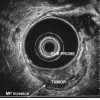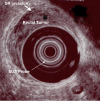The role of endoscopic ultrasound in the evaluation of rectal cancer
- PMID: 17049086
- PMCID: PMC1630427
- DOI: 10.1186/1477-7800-3-36
The role of endoscopic ultrasound in the evaluation of rectal cancer
Abstract
Accurate staging of rectal cancer is essential for selecting patients who can undergo sphincter-preserving surgery. It may also identify patients who could benefit from neoadjuvant therapy. Clinical staging is usually accomplished using a combination of physical examination, CT scanning, MRI and endoscopic ultrasound (EUS). Transrectal EUS is increasingly being used for locoregional staging of rectal cancer. The accuracy of EUS for the T staging of rectal carcinoma ranges from 80-95% compared with CT (65-75%) and MR imaging (75-85%). In comparison to CT, EUS can potentially upstage patients, making them eligible for neoadjuvant treatment. The accuracy to determine metastatic nodal involvement by EUS is approximately 70-75% compared with CT (55-65%) and MR imaging (60-70%). EUS guided FNA may be beneficial in patients who appear to have early T stage disease and suspicious peri-iliac lymphadenopathy to exclude metastatic disease.
Figures




References
-
- Jemal A, Siegel R, Ward E, Murray T, Xu J, Smigal C, Thun MJ. Cancer statistics, 2006. CA Cancer J Clin. 2006;56:106–130. - PubMed
LinkOut - more resources
Full Text Sources

